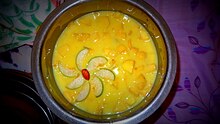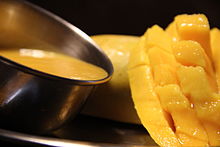 Aamras from India | |
| Course | sauce |
|---|---|
| Place of origin | Indian subcontinent |
| Associated cuisine | India, Bangladesh, Pakistan |
| Serving temperature | Chilled |
| Main ingredients | Mango, milk |

Aamras (also known as amras) is a sweet dish in the cuisine of the Indian subcontinent made from the pulp of the mango fruit. The pulp of a ripe mango is extracted, usually by hand, and is eaten together with pooris or chapatis, Indian breads. Sometimes ghee and milk are added to the pulp to enhance its flavour. Sugar may be added for sweetness. It is often eaten at celebrations and weddings with cardamon and chopped fruits.
A regional version of aamras is a popular dessert in Rajasthani cuisine and Marwari, Marathi, and Gujarati homes, especially during festivities.
Since the fruit is seasonal, being harvested at the end of summer, the need to preserve the fruit in the form of pulp has given rise to a moderately large mango-processing industry.
Etymology[edit]
The word "aamras" is derived from the Sanskrit words āmra (Sanskrit: आम्र; lit. 'mango') and rasa (Sanskrit: रस; lit. 'juice'), so the literal meaning is "mango juice".
Panhe[edit]
Panhe is a traditional summertime drink in Maharashtra, a sweet drink made with the pulp of boiled raw mangoes mixed with half the amount of sugar and diluted with water. The drink helps in tolerating the heat.
Keri no ras[edit]
Aamras is also a traditional Gujarati dish (called કેરીનો રસ (kerī-no ras)). It consists of sugared mango pulp, which is passed through muslin to remove fibrous strands of the fruit.[1] It is commonly eaten with rotil or pooris.[2]
List of sweetmeats produced from processing the pulp[edit]
Several sweetmeats produced from the processed pulp are very popular among the Maharastrian community.
- Amba Barfi: The pulp is mixed with sugar and reduced to a thick paste by boiling. The reduced pulp is then mixed with khoa (milk solids) and chopped nuts. The mixture is allowed to cool in large flat pans and cut into cubes before packaging.
- Amba Poli: The pulp is mixed with sugar and sundried on flat steel plates. The dried pulp forms stiff layers which are stacked on top of each other. The stacks are then cut into large squares before packaging.
- Ambebhat: The pulp is mixed with sugar and nuts, then cooked along with boiled white rice. Once the pulp is reduced and evenly coats the rice grains, the Ambebath is ready to be consumed.
- Ambyacha Shira: The pulp is mixed with sugar and nuts, then cooked along with semolina in water or milk. Once cooked, the mixture looks like an amber-coloured paste and is ready to be consumed.
References[edit]
- ^ Vanisha, S.R., Nambier, Vashist (2004). A Textbook On Food Contamination And Safety. Anmol Publications. p. 52. ISBN 9788126119592. Archived from the original on 2023-04-25. Retrieved 2020-12-06.
{{cite book}}: CS1 maint: multiple names: authors list (link) - ^ Seshadri, Diana (2007). Food for the Gods. Lulu.com. p. 47. ISBN 978-1-4303-1269-7. Archived from the original on 2023-04-25. Retrieved 2020-12-06.
External links[edit]
 Media related to Aamras at Wikimedia Commons
Media related to Aamras at Wikimedia Commons
